Human Resource Management Essay: Workplace Surveillance and Monitoring
VerifiedAdded on 2020/07/23
|8
|2266
|77
Essay
AI Summary
This essay provides a comprehensive overview of workplace surveillance within the context of Human Resource Management (HRM). It begins with an introduction to HRM and the role of surveillance in addressing security breaches, theft, and employee conduct. The essay then defines workplace surveillance, emphasizing the use of various monitoring methods such as CCTV cameras and the importance of balancing employee privacy with organizational needs. It delves into the importance of surveillance, highlighting its role in reducing theft, improving employee performance, and ensuring customer record protection. The essay further examines different types of monitoring, including computer, video, and electronic mail surveillance, along with software and hardware surveillance and the use of undercover operatives. It also covers the advantages and disadvantages of employee monitoring, such as increased productivity versus stress and privacy concerns. Ethical considerations of monitoring employees are discussed, including the need to balance privacy with the protection of company assets. The essay concludes by emphasizing the challenges and legal frameworks surrounding workplace surveillance, and the need for organizations to create a safe and productive work environment.

HRM
ACADEMIC
ESSAY
ACADEMIC
ESSAY
Paraphrase This Document
Need a fresh take? Get an instant paraphrase of this document with our AI Paraphraser
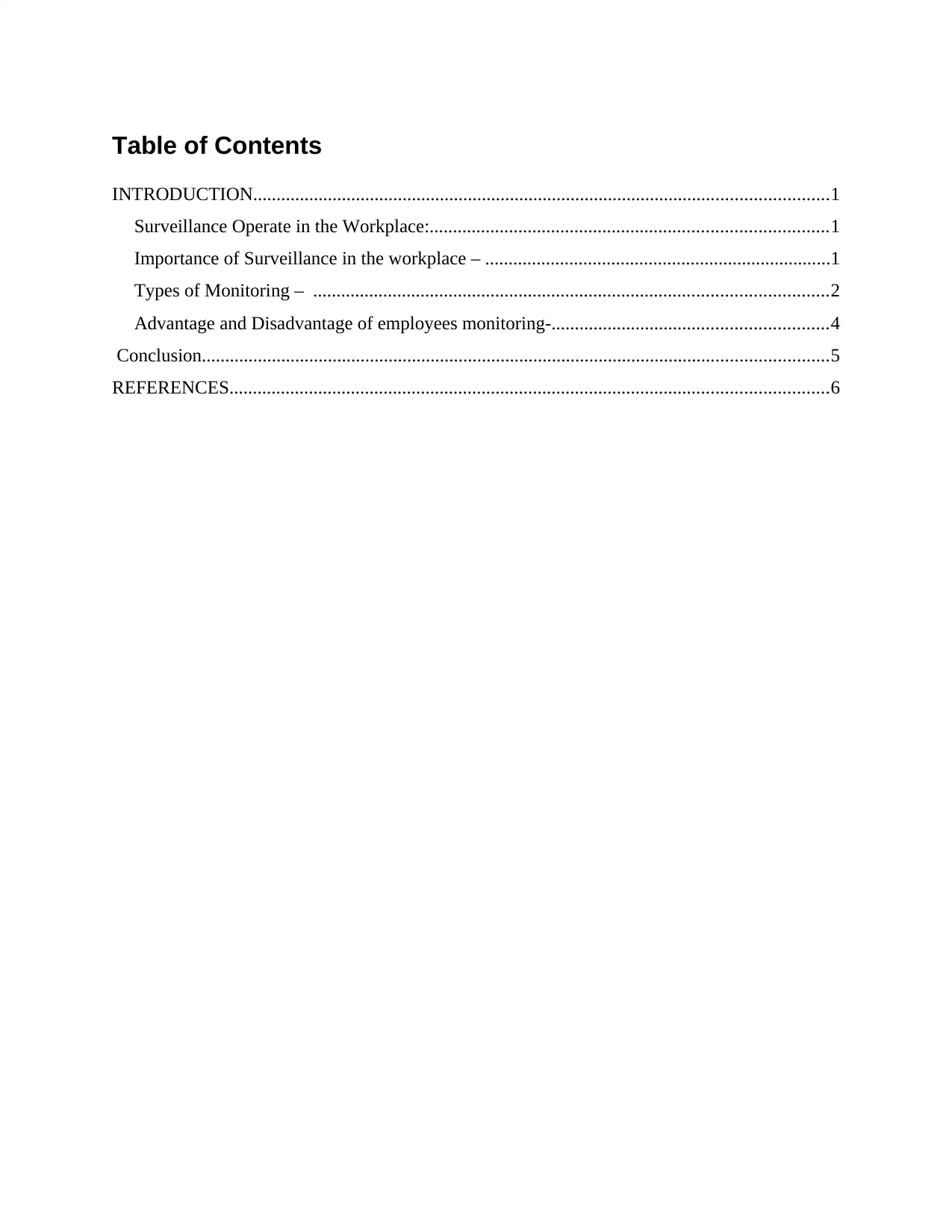
Table of Contents
INTRODUCTION...........................................................................................................................1
Surveillance Operate in the Workplace:.....................................................................................1
Importance of Surveillance in the workplace – ..........................................................................1
Types of Monitoring – ..............................................................................................................2
Advantage and Disadvantage of employees monitoring-...........................................................4
Conclusion......................................................................................................................................5
REFERENCES................................................................................................................................6
INTRODUCTION...........................................................................................................................1
Surveillance Operate in the Workplace:.....................................................................................1
Importance of Surveillance in the workplace – ..........................................................................1
Types of Monitoring – ..............................................................................................................2
Advantage and Disadvantage of employees monitoring-...........................................................4
Conclusion......................................................................................................................................5
REFERENCES................................................................................................................................6
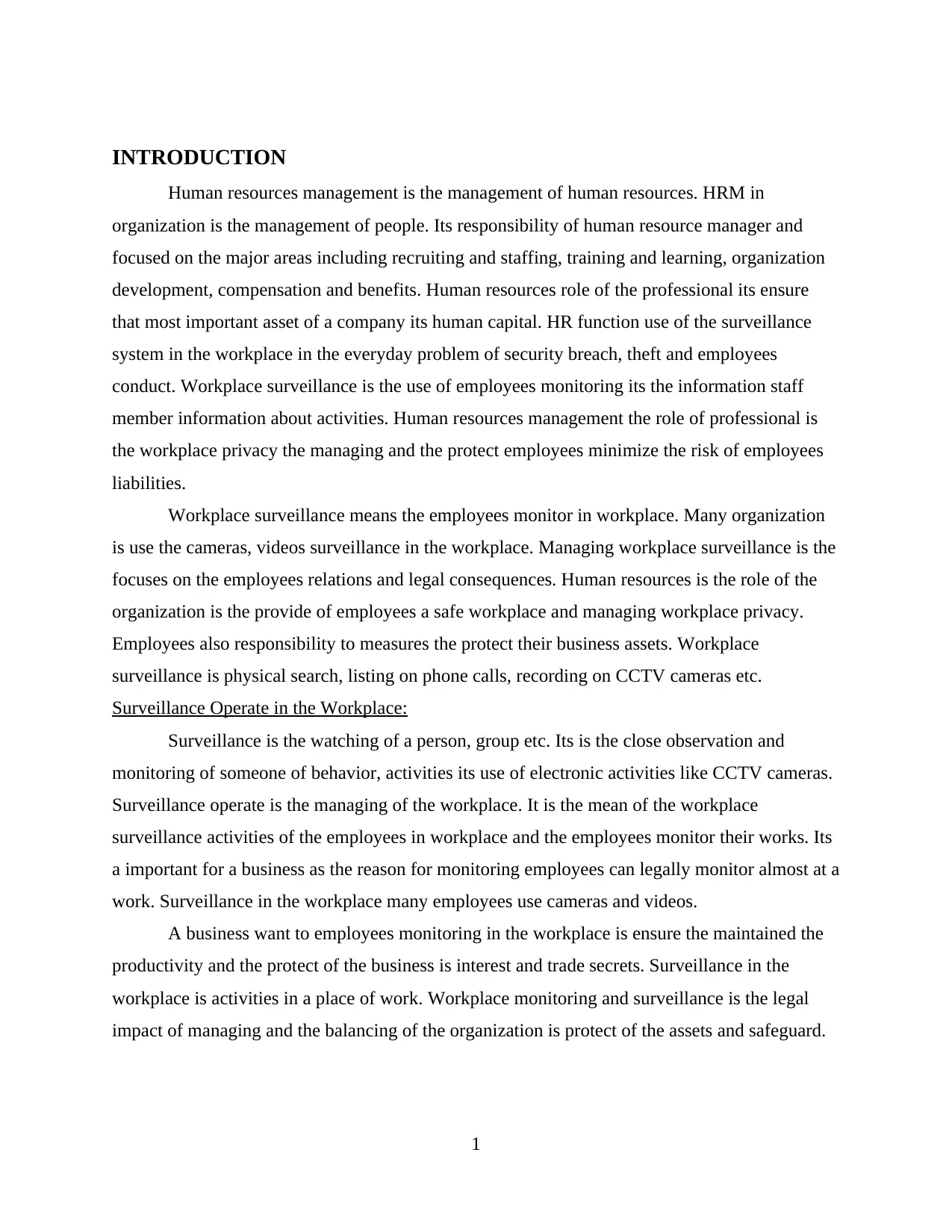
INTRODUCTION
Human resources management is the management of human resources. HRM in
organization is the management of people. Its responsibility of human resource manager and
focused on the major areas including recruiting and staffing, training and learning, organization
development, compensation and benefits. Human resources role of the professional its ensure
that most important asset of a company its human capital. HR function use of the surveillance
system in the workplace in the everyday problem of security breach, theft and employees
conduct. Workplace surveillance is the use of employees monitoring its the information staff
member information about activities. Human resources management the role of professional is
the workplace privacy the managing and the protect employees minimize the risk of employees
liabilities.
Workplace surveillance means the employees monitor in workplace. Many organization
is use the cameras, videos surveillance in the workplace. Managing workplace surveillance is the
focuses on the employees relations and legal consequences. Human resources is the role of the
organization is the provide of employees a safe workplace and managing workplace privacy.
Employees also responsibility to measures the protect their business assets. Workplace
surveillance is physical search, listing on phone calls, recording on CCTV cameras etc.
Surveillance Operate in the Workplace:
Surveillance is the watching of a person, group etc. Its is the close observation and
monitoring of someone of behavior, activities its use of electronic activities like CCTV cameras.
Surveillance operate is the managing of the workplace. It is the mean of the workplace
surveillance activities of the employees in workplace and the employees monitor their works. Its
a important for a business as the reason for monitoring employees can legally monitor almost at a
work. Surveillance in the workplace many employees use cameras and videos.
A business want to employees monitoring in the workplace is ensure the maintained the
productivity and the protect of the business is interest and trade secrets. Surveillance in the
workplace is activities in a place of work. Workplace monitoring and surveillance is the legal
impact of managing and the balancing of the organization is protect of the assets and safeguard.
1
Human resources management is the management of human resources. HRM in
organization is the management of people. Its responsibility of human resource manager and
focused on the major areas including recruiting and staffing, training and learning, organization
development, compensation and benefits. Human resources role of the professional its ensure
that most important asset of a company its human capital. HR function use of the surveillance
system in the workplace in the everyday problem of security breach, theft and employees
conduct. Workplace surveillance is the use of employees monitoring its the information staff
member information about activities. Human resources management the role of professional is
the workplace privacy the managing and the protect employees minimize the risk of employees
liabilities.
Workplace surveillance means the employees monitor in workplace. Many organization
is use the cameras, videos surveillance in the workplace. Managing workplace surveillance is the
focuses on the employees relations and legal consequences. Human resources is the role of the
organization is the provide of employees a safe workplace and managing workplace privacy.
Employees also responsibility to measures the protect their business assets. Workplace
surveillance is physical search, listing on phone calls, recording on CCTV cameras etc.
Surveillance Operate in the Workplace:
Surveillance is the watching of a person, group etc. Its is the close observation and
monitoring of someone of behavior, activities its use of electronic activities like CCTV cameras.
Surveillance operate is the managing of the workplace. It is the mean of the workplace
surveillance activities of the employees in workplace and the employees monitor their works. Its
a important for a business as the reason for monitoring employees can legally monitor almost at a
work. Surveillance in the workplace many employees use cameras and videos.
A business want to employees monitoring in the workplace is ensure the maintained the
productivity and the protect of the business is interest and trade secrets. Surveillance in the
workplace is activities in a place of work. Workplace monitoring and surveillance is the legal
impact of managing and the balancing of the organization is protect of the assets and safeguard.
1
⊘ This is a preview!⊘
Do you want full access?
Subscribe today to unlock all pages.

Trusted by 1+ million students worldwide
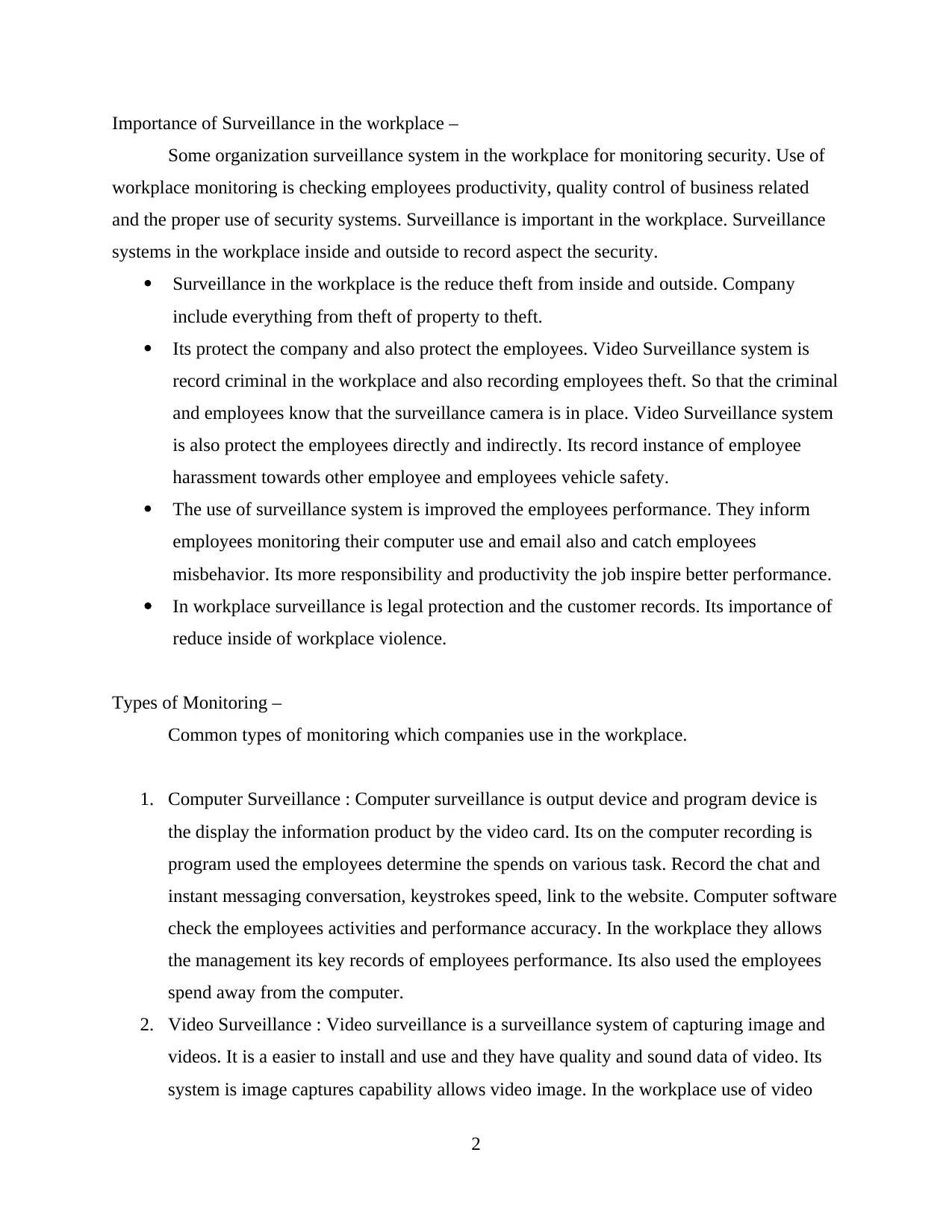
Importance of Surveillance in the workplace –
Some organization surveillance system in the workplace for monitoring security. Use of
workplace monitoring is checking employees productivity, quality control of business related
and the proper use of security systems. Surveillance is important in the workplace. Surveillance
systems in the workplace inside and outside to record aspect the security.
Surveillance in the workplace is the reduce theft from inside and outside. Company
include everything from theft of property to theft.
Its protect the company and also protect the employees. Video Surveillance system is
record criminal in the workplace and also recording employees theft. So that the criminal
and employees know that the surveillance camera is in place. Video Surveillance system
is also protect the employees directly and indirectly. Its record instance of employee
harassment towards other employee and employees vehicle safety.
The use of surveillance system is improved the employees performance. They inform
employees monitoring their computer use and email also and catch employees
misbehavior. Its more responsibility and productivity the job inspire better performance.
In workplace surveillance is legal protection and the customer records. Its importance of
reduce inside of workplace violence.
Types of Monitoring –
Common types of monitoring which companies use in the workplace.
1. Computer Surveillance : Computer surveillance is output device and program device is
the display the information product by the video card. Its on the computer recording is
program used the employees determine the spends on various task. Record the chat and
instant messaging conversation, keystrokes speed, link to the website. Computer software
check the employees activities and performance accuracy. In the workplace they allows
the management its key records of employees performance. Its also used the employees
spend away from the computer.
2. Video Surveillance : Video surveillance is a surveillance system of capturing image and
videos. It is a easier to install and use and they have quality and sound data of video. Its
system is image captures capability allows video image. In the workplace use of video
2
Some organization surveillance system in the workplace for monitoring security. Use of
workplace monitoring is checking employees productivity, quality control of business related
and the proper use of security systems. Surveillance is important in the workplace. Surveillance
systems in the workplace inside and outside to record aspect the security.
Surveillance in the workplace is the reduce theft from inside and outside. Company
include everything from theft of property to theft.
Its protect the company and also protect the employees. Video Surveillance system is
record criminal in the workplace and also recording employees theft. So that the criminal
and employees know that the surveillance camera is in place. Video Surveillance system
is also protect the employees directly and indirectly. Its record instance of employee
harassment towards other employee and employees vehicle safety.
The use of surveillance system is improved the employees performance. They inform
employees monitoring their computer use and email also and catch employees
misbehavior. Its more responsibility and productivity the job inspire better performance.
In workplace surveillance is legal protection and the customer records. Its importance of
reduce inside of workplace violence.
Types of Monitoring –
Common types of monitoring which companies use in the workplace.
1. Computer Surveillance : Computer surveillance is output device and program device is
the display the information product by the video card. Its on the computer recording is
program used the employees determine the spends on various task. Record the chat and
instant messaging conversation, keystrokes speed, link to the website. Computer software
check the employees activities and performance accuracy. In the workplace they allows
the management its key records of employees performance. Its also used the employees
spend away from the computer.
2. Video Surveillance : Video surveillance is a surveillance system of capturing image and
videos. It is a easier to install and use and they have quality and sound data of video. Its
system is image captures capability allows video image. In the workplace use of video
2
Paraphrase This Document
Need a fresh take? Get an instant paraphrase of this document with our AI Paraphraser
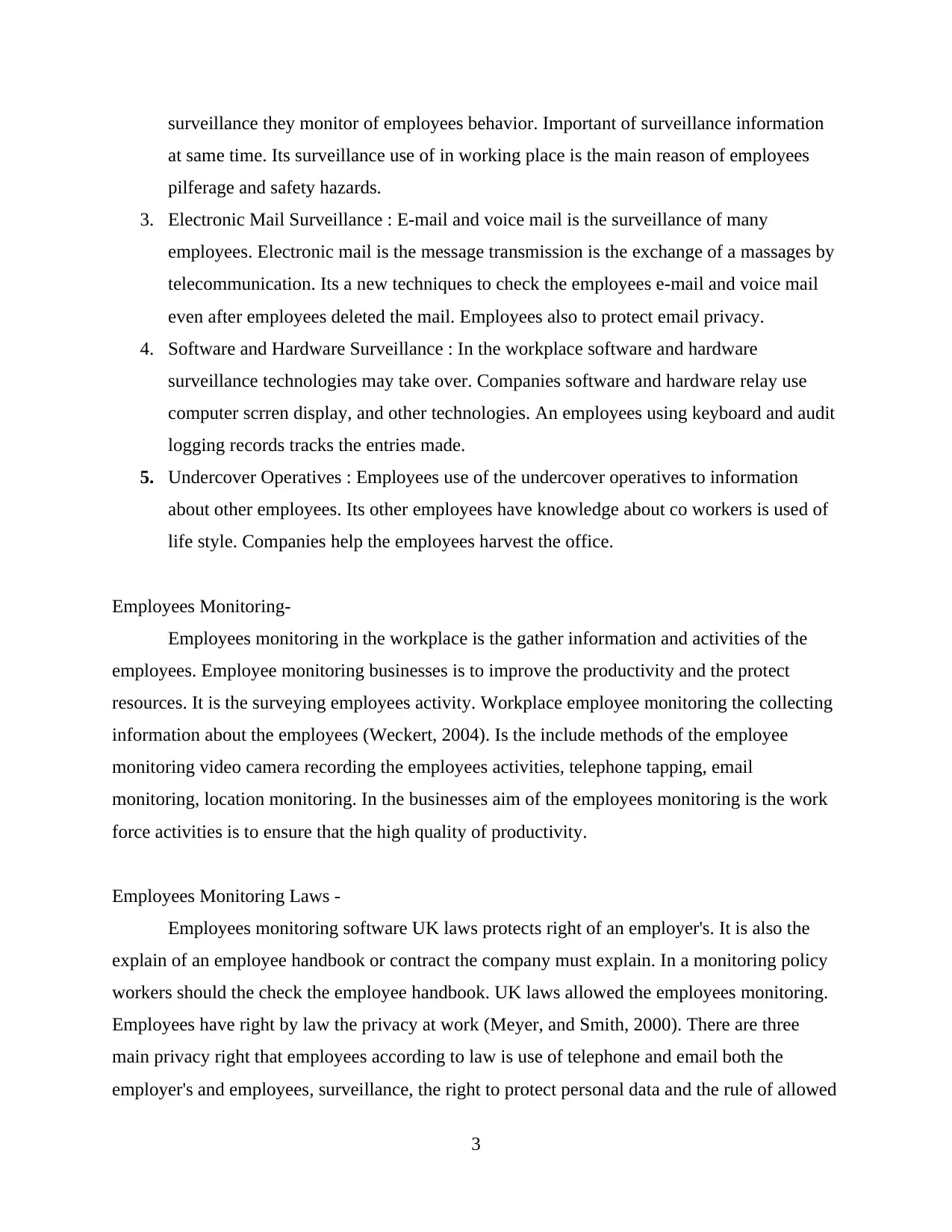
surveillance they monitor of employees behavior. Important of surveillance information
at same time. Its surveillance use of in working place is the main reason of employees
pilferage and safety hazards.
3. Electronic Mail Surveillance : E-mail and voice mail is the surveillance of many
employees. Electronic mail is the message transmission is the exchange of a massages by
telecommunication. Its a new techniques to check the employees e-mail and voice mail
even after employees deleted the mail. Employees also to protect email privacy.
4. Software and Hardware Surveillance : In the workplace software and hardware
surveillance technologies may take over. Companies software and hardware relay use
computer scrren display, and other technologies. An employees using keyboard and audit
logging records tracks the entries made.
5. Undercover Operatives : Employees use of the undercover operatives to information
about other employees. Its other employees have knowledge about co workers is used of
life style. Companies help the employees harvest the office.
Employees Monitoring-
Employees monitoring in the workplace is the gather information and activities of the
employees. Employee monitoring businesses is to improve the productivity and the protect
resources. It is the surveying employees activity. Workplace employee monitoring the collecting
information about the employees (Weckert, 2004). Is the include methods of the employee
monitoring video camera recording the employees activities, telephone tapping, email
monitoring, location monitoring. In the businesses aim of the employees monitoring is the work
force activities is to ensure that the high quality of productivity.
Employees Monitoring Laws -
Employees monitoring software UK laws protects right of an employer's. It is also the
explain of an employee handbook or contract the company must explain. In a monitoring policy
workers should the check the employee handbook. UK laws allowed the employees monitoring.
Employees have right by law the privacy at work (Meyer, and Smith, 2000). There are three
main privacy right that employees according to law is use of telephone and email both the
employer's and employees, surveillance, the right to protect personal data and the rule of allowed
3
at same time. Its surveillance use of in working place is the main reason of employees
pilferage and safety hazards.
3. Electronic Mail Surveillance : E-mail and voice mail is the surveillance of many
employees. Electronic mail is the message transmission is the exchange of a massages by
telecommunication. Its a new techniques to check the employees e-mail and voice mail
even after employees deleted the mail. Employees also to protect email privacy.
4. Software and Hardware Surveillance : In the workplace software and hardware
surveillance technologies may take over. Companies software and hardware relay use
computer scrren display, and other technologies. An employees using keyboard and audit
logging records tracks the entries made.
5. Undercover Operatives : Employees use of the undercover operatives to information
about other employees. Its other employees have knowledge about co workers is used of
life style. Companies help the employees harvest the office.
Employees Monitoring-
Employees monitoring in the workplace is the gather information and activities of the
employees. Employee monitoring businesses is to improve the productivity and the protect
resources. It is the surveying employees activity. Workplace employee monitoring the collecting
information about the employees (Weckert, 2004). Is the include methods of the employee
monitoring video camera recording the employees activities, telephone tapping, email
monitoring, location monitoring. In the businesses aim of the employees monitoring is the work
force activities is to ensure that the high quality of productivity.
Employees Monitoring Laws -
Employees monitoring software UK laws protects right of an employer's. It is also the
explain of an employee handbook or contract the company must explain. In a monitoring policy
workers should the check the employee handbook. UK laws allowed the employees monitoring.
Employees have right by law the privacy at work (Meyer, and Smith, 2000). There are three
main privacy right that employees according to law is use of telephone and email both the
employer's and employees, surveillance, the right to protect personal data and the rule of allowed
3
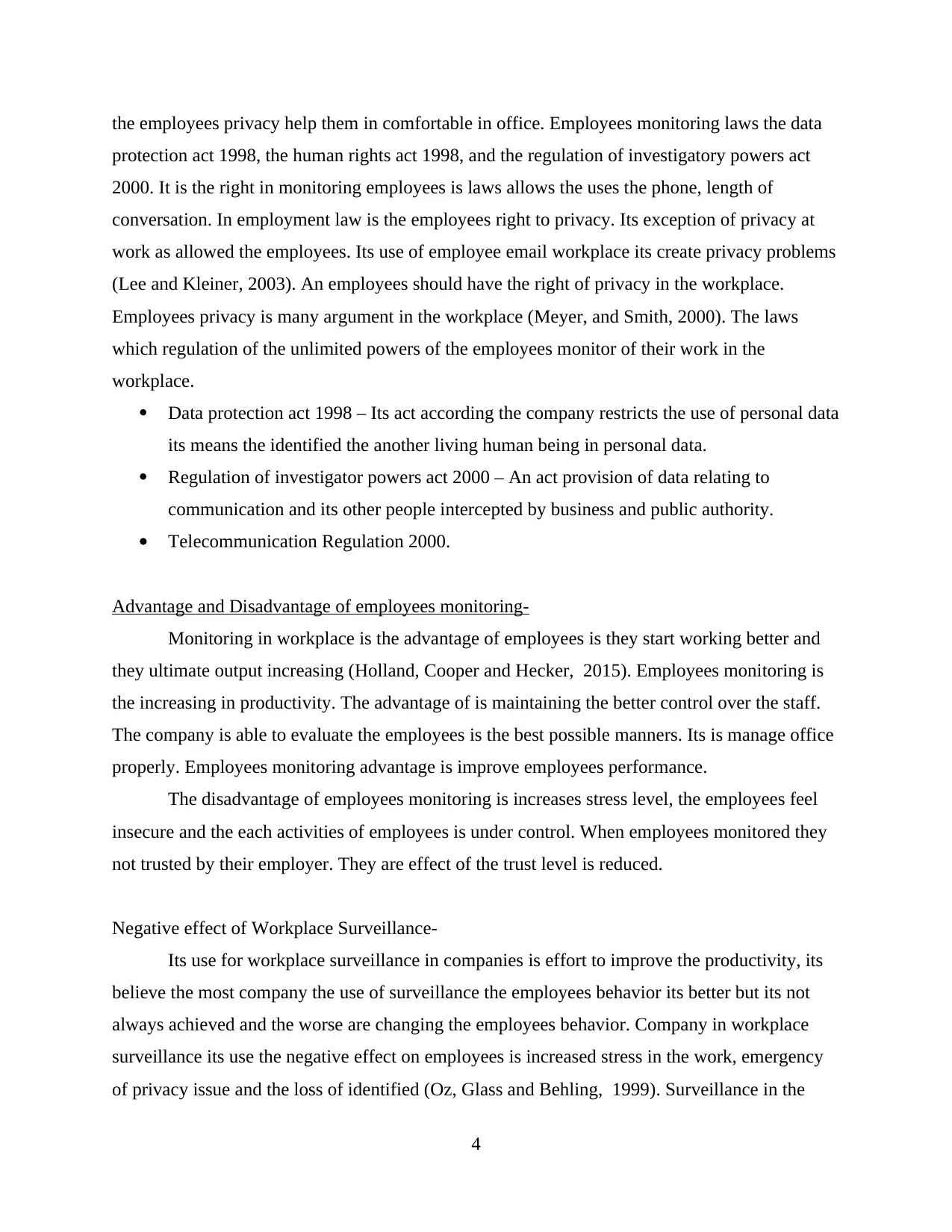
the employees privacy help them in comfortable in office. Employees monitoring laws the data
protection act 1998, the human rights act 1998, and the regulation of investigatory powers act
2000. It is the right in monitoring employees is laws allows the uses the phone, length of
conversation. In employment law is the employees right to privacy. Its exception of privacy at
work as allowed the employees. Its use of employee email workplace its create privacy problems
(Lee and Kleiner, 2003). An employees should have the right of privacy in the workplace.
Employees privacy is many argument in the workplace (Meyer, and Smith, 2000). The laws
which regulation of the unlimited powers of the employees monitor of their work in the
workplace.
Data protection act 1998 – Its act according the company restricts the use of personal data
its means the identified the another living human being in personal data.
Regulation of investigator powers act 2000 – An act provision of data relating to
communication and its other people intercepted by business and public authority.
Telecommunication Regulation 2000.
Advantage and Disadvantage of employees monitoring-
Monitoring in workplace is the advantage of employees is they start working better and
they ultimate output increasing (Holland, Cooper and Hecker, 2015). Employees monitoring is
the increasing in productivity. The advantage of is maintaining the better control over the staff.
The company is able to evaluate the employees is the best possible manners. Its is manage office
properly. Employees monitoring advantage is improve employees performance.
The disadvantage of employees monitoring is increases stress level, the employees feel
insecure and the each activities of employees is under control. When employees monitored they
not trusted by their employer. They are effect of the trust level is reduced.
Negative effect of Workplace Surveillance-
Its use for workplace surveillance in companies is effort to improve the productivity, its
believe the most company the use of surveillance the employees behavior its better but its not
always achieved and the worse are changing the employees behavior. Company in workplace
surveillance its use the negative effect on employees is increased stress in the work, emergency
of privacy issue and the loss of identified (Oz, Glass and Behling, 1999). Surveillance in the
4
protection act 1998, the human rights act 1998, and the regulation of investigatory powers act
2000. It is the right in monitoring employees is laws allows the uses the phone, length of
conversation. In employment law is the employees right to privacy. Its exception of privacy at
work as allowed the employees. Its use of employee email workplace its create privacy problems
(Lee and Kleiner, 2003). An employees should have the right of privacy in the workplace.
Employees privacy is many argument in the workplace (Meyer, and Smith, 2000). The laws
which regulation of the unlimited powers of the employees monitor of their work in the
workplace.
Data protection act 1998 – Its act according the company restricts the use of personal data
its means the identified the another living human being in personal data.
Regulation of investigator powers act 2000 – An act provision of data relating to
communication and its other people intercepted by business and public authority.
Telecommunication Regulation 2000.
Advantage and Disadvantage of employees monitoring-
Monitoring in workplace is the advantage of employees is they start working better and
they ultimate output increasing (Holland, Cooper and Hecker, 2015). Employees monitoring is
the increasing in productivity. The advantage of is maintaining the better control over the staff.
The company is able to evaluate the employees is the best possible manners. Its is manage office
properly. Employees monitoring advantage is improve employees performance.
The disadvantage of employees monitoring is increases stress level, the employees feel
insecure and the each activities of employees is under control. When employees monitored they
not trusted by their employer. They are effect of the trust level is reduced.
Negative effect of Workplace Surveillance-
Its use for workplace surveillance in companies is effort to improve the productivity, its
believe the most company the use of surveillance the employees behavior its better but its not
always achieved and the worse are changing the employees behavior. Company in workplace
surveillance its use the negative effect on employees is increased stress in the work, emergency
of privacy issue and the loss of identified (Oz, Glass and Behling, 1999). Surveillance in the
4
⊘ This is a preview!⊘
Do you want full access?
Subscribe today to unlock all pages.

Trusted by 1+ million students worldwide
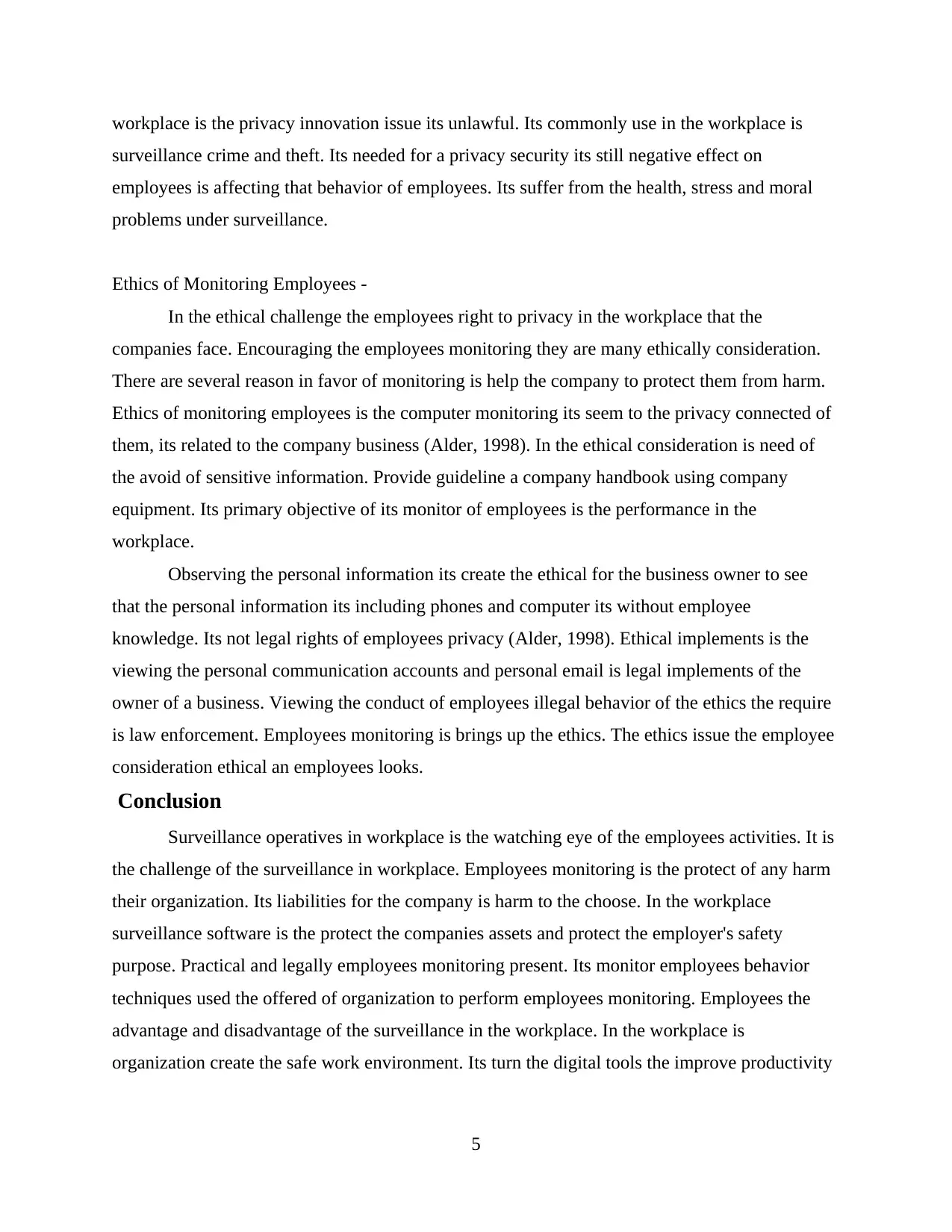
workplace is the privacy innovation issue its unlawful. Its commonly use in the workplace is
surveillance crime and theft. Its needed for a privacy security its still negative effect on
employees is affecting that behavior of employees. Its suffer from the health, stress and moral
problems under surveillance.
Ethics of Monitoring Employees -
In the ethical challenge the employees right to privacy in the workplace that the
companies face. Encouraging the employees monitoring they are many ethically consideration.
There are several reason in favor of monitoring is help the company to protect them from harm.
Ethics of monitoring employees is the computer monitoring its seem to the privacy connected of
them, its related to the company business (Alder, 1998). In the ethical consideration is need of
the avoid of sensitive information. Provide guideline a company handbook using company
equipment. Its primary objective of its monitor of employees is the performance in the
workplace.
Observing the personal information its create the ethical for the business owner to see
that the personal information its including phones and computer its without employee
knowledge. Its not legal rights of employees privacy (Alder, 1998). Ethical implements is the
viewing the personal communication accounts and personal email is legal implements of the
owner of a business. Viewing the conduct of employees illegal behavior of the ethics the require
is law enforcement. Employees monitoring is brings up the ethics. The ethics issue the employee
consideration ethical an employees looks.
Conclusion
Surveillance operatives in workplace is the watching eye of the employees activities. It is
the challenge of the surveillance in workplace. Employees monitoring is the protect of any harm
their organization. Its liabilities for the company is harm to the choose. In the workplace
surveillance software is the protect the companies assets and protect the employer's safety
purpose. Practical and legally employees monitoring present. Its monitor employees behavior
techniques used the offered of organization to perform employees monitoring. Employees the
advantage and disadvantage of the surveillance in the workplace. In the workplace is
organization create the safe work environment. Its turn the digital tools the improve productivity
5
surveillance crime and theft. Its needed for a privacy security its still negative effect on
employees is affecting that behavior of employees. Its suffer from the health, stress and moral
problems under surveillance.
Ethics of Monitoring Employees -
In the ethical challenge the employees right to privacy in the workplace that the
companies face. Encouraging the employees monitoring they are many ethically consideration.
There are several reason in favor of monitoring is help the company to protect them from harm.
Ethics of monitoring employees is the computer monitoring its seem to the privacy connected of
them, its related to the company business (Alder, 1998). In the ethical consideration is need of
the avoid of sensitive information. Provide guideline a company handbook using company
equipment. Its primary objective of its monitor of employees is the performance in the
workplace.
Observing the personal information its create the ethical for the business owner to see
that the personal information its including phones and computer its without employee
knowledge. Its not legal rights of employees privacy (Alder, 1998). Ethical implements is the
viewing the personal communication accounts and personal email is legal implements of the
owner of a business. Viewing the conduct of employees illegal behavior of the ethics the require
is law enforcement. Employees monitoring is brings up the ethics. The ethics issue the employee
consideration ethical an employees looks.
Conclusion
Surveillance operatives in workplace is the watching eye of the employees activities. It is
the challenge of the surveillance in workplace. Employees monitoring is the protect of any harm
their organization. Its liabilities for the company is harm to the choose. In the workplace
surveillance software is the protect the companies assets and protect the employer's safety
purpose. Practical and legally employees monitoring present. Its monitor employees behavior
techniques used the offered of organization to perform employees monitoring. Employees the
advantage and disadvantage of the surveillance in the workplace. In the workplace is
organization create the safe work environment. Its turn the digital tools the improve productivity
5
Paraphrase This Document
Need a fresh take? Get an instant paraphrase of this document with our AI Paraphraser
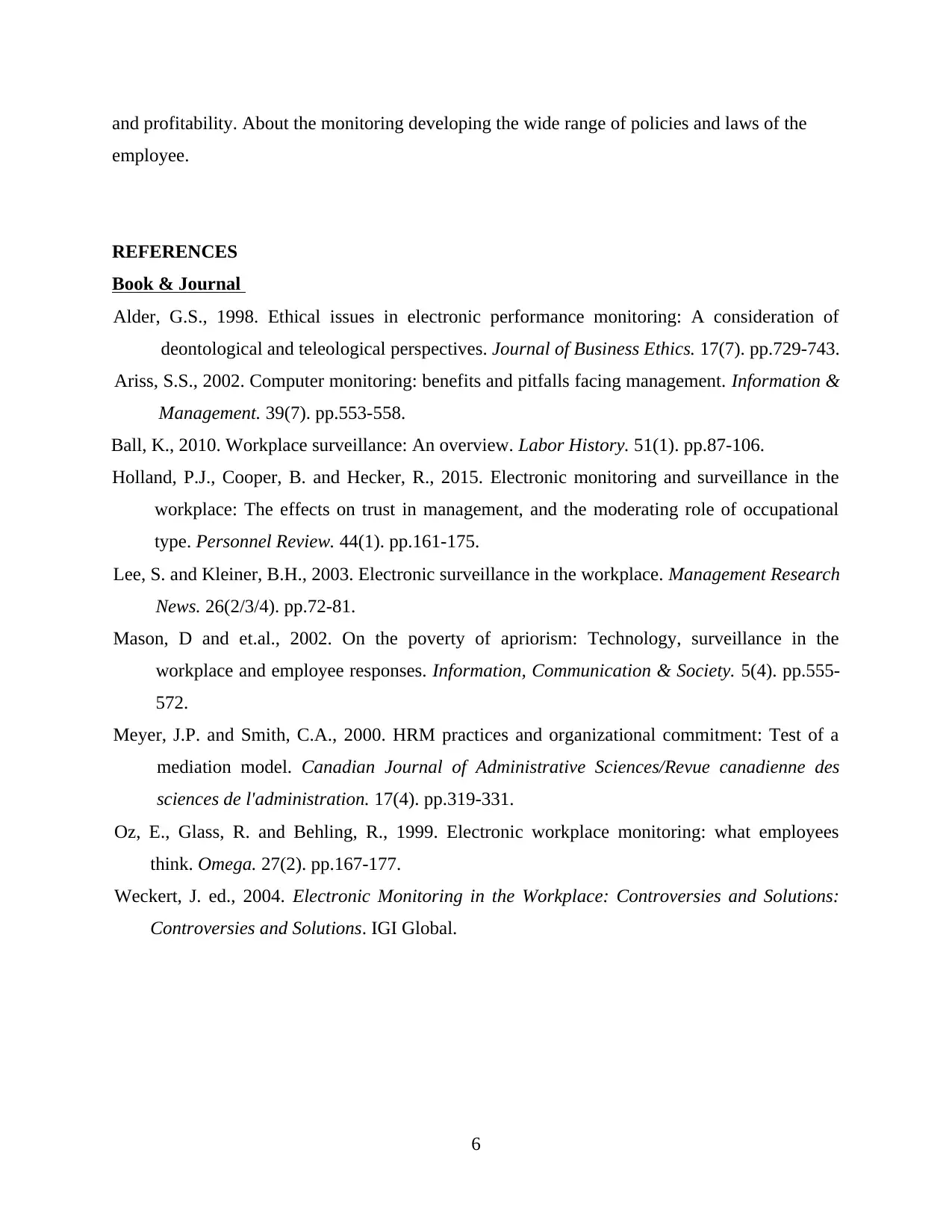
and profitability. About the monitoring developing the wide range of policies and laws of the
employee.
REFERENCES
Book & Journal
Alder, G.S., 1998. Ethical issues in electronic performance monitoring: A consideration of
deontological and teleological perspectives. Journal of Business Ethics. 17(7). pp.729-743.
Ariss, S.S., 2002. Computer monitoring: benefits and pitfalls facing management. Information &
Management. 39(7). pp.553-558.
Ball, K., 2010. Workplace surveillance: An overview. Labor History. 51(1). pp.87-106.
Holland, P.J., Cooper, B. and Hecker, R., 2015. Electronic monitoring and surveillance in the
workplace: The effects on trust in management, and the moderating role of occupational
type. Personnel Review. 44(1). pp.161-175.
Lee, S. and Kleiner, B.H., 2003. Electronic surveillance in the workplace. Management Research
News. 26(2/3/4). pp.72-81.
Mason, D and et.al., 2002. On the poverty of apriorism: Technology, surveillance in the
workplace and employee responses. Information, Communication & Society. 5(4). pp.555-
572.
Meyer, J.P. and Smith, C.A., 2000. HRM practices and organizational commitment: Test of a
mediation model. Canadian Journal of Administrative Sciences/Revue canadienne des
sciences de l'administration. 17(4). pp.319-331.
Oz, E., Glass, R. and Behling, R., 1999. Electronic workplace monitoring: what employees
think. Omega. 27(2). pp.167-177.
Weckert, J. ed., 2004. Electronic Monitoring in the Workplace: Controversies and Solutions:
Controversies and Solutions. IGI Global.
6
employee.
REFERENCES
Book & Journal
Alder, G.S., 1998. Ethical issues in electronic performance monitoring: A consideration of
deontological and teleological perspectives. Journal of Business Ethics. 17(7). pp.729-743.
Ariss, S.S., 2002. Computer monitoring: benefits and pitfalls facing management. Information &
Management. 39(7). pp.553-558.
Ball, K., 2010. Workplace surveillance: An overview. Labor History. 51(1). pp.87-106.
Holland, P.J., Cooper, B. and Hecker, R., 2015. Electronic monitoring and surveillance in the
workplace: The effects on trust in management, and the moderating role of occupational
type. Personnel Review. 44(1). pp.161-175.
Lee, S. and Kleiner, B.H., 2003. Electronic surveillance in the workplace. Management Research
News. 26(2/3/4). pp.72-81.
Mason, D and et.al., 2002. On the poverty of apriorism: Technology, surveillance in the
workplace and employee responses. Information, Communication & Society. 5(4). pp.555-
572.
Meyer, J.P. and Smith, C.A., 2000. HRM practices and organizational commitment: Test of a
mediation model. Canadian Journal of Administrative Sciences/Revue canadienne des
sciences de l'administration. 17(4). pp.319-331.
Oz, E., Glass, R. and Behling, R., 1999. Electronic workplace monitoring: what employees
think. Omega. 27(2). pp.167-177.
Weckert, J. ed., 2004. Electronic Monitoring in the Workplace: Controversies and Solutions:
Controversies and Solutions. IGI Global.
6
1 out of 8
Related Documents
Your All-in-One AI-Powered Toolkit for Academic Success.
+13062052269
info@desklib.com
Available 24*7 on WhatsApp / Email
![[object Object]](/_next/static/media/star-bottom.7253800d.svg)
Unlock your academic potential
Copyright © 2020–2025 A2Z Services. All Rights Reserved. Developed and managed by ZUCOL.





